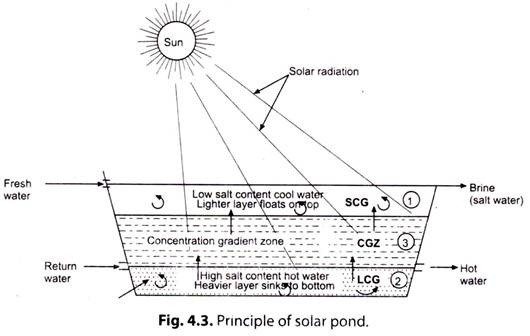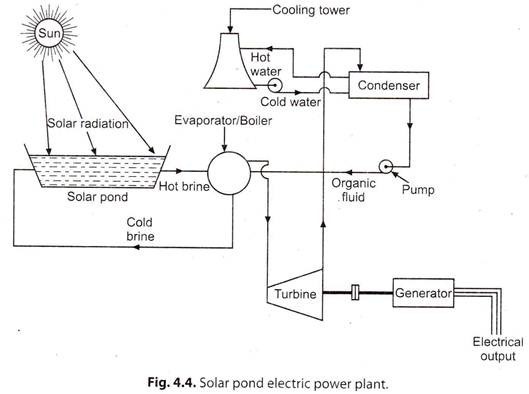Are you looking for an essay on ‘Solar Ponds’? Find paragraphs, long and short essays on ‘Solar Ponds’ especially written for school and college students.
Essay # 1. Introduction to Solar Ponds:
Solar pond, also called solar ‘salt pond’, is an artificially designed pond, filled with salty water, maintaining a definite concentration gradient. It combines solar energy radiation and sensible heat storage, and as such, it is utilised for collecting and storing solar energy.
A solar pond reduces the convective and evaporative heat losses by reversing the temperature gradient with the help of non-uniform vertical concentration of salts.
Fig. 4.3 illustrates the principle of solar pond.
The vertical configuration of “salt gradient solar pond” normally consists of the following three zones:
1. “Surface (homogeneous) convective zone (SCZ)”- It is adjacent to the surface and serves as a buffer zone between environmental fluctuations at the surface and conductive heat transport from the layer below. It, is about 10 to 20 cm thick with a low uniform concentration at nearly the ambient air temperature.
2. “Lower connective zone (LCG)”- It is at the bottom of the pond, and this is the layer with highest salt concentration, where high temperatures are built up.
3. “Concentration/Intermediate gradient zone (CGZ)”- This zone keeps the two convective zones (SCG and LCG) apart and gives the solar pond its unique thermal performance. It provides excellent insulation for the storage layer, while transmitting the solar radiation. To maintain a solar pond in this non-equilibrium stationary state it is necessary to replace the amount of salt that is transported by molecular diffusion from the LCG to SCZ. This means that salt must be added to the LCG, and fresh water to the SCG whilst brine is removed. The brine can be recycled, divided into water and salt (by solar distillation) and returned to the pond.
The major heat loss occurs from the surface of the solar pond. This heat loss can be prevented by spreading a plastic grid over the pond’s surface to prevent disturbance by the wind. Disturbed water tends to lose heat transfer faster than when calm.
Due to the excessively high salt concentration of the LCZ, a plastic liner or impermeable soil must be used to prevent infiltration into the nearby ground water or soil. The liner is a factor that increases the cost of a solar pond. A site where the soil is naturally impermeable, such as the base of a natural pond or lake, or can be made impermeable by compaction or other means, will allow considerably lower power costs.
The optical transmission properties and related collection efficiency vary greatly and depend on the following factors:
(i) Salt concentration.
(ii) The quantity of suspended dust or other particles.
(iii) Surface impurities like leaves or debris, biological material like bacteria and algae.
(iv) The type of salt.
It becomes obvious that much higher efficiencies and storage can be achieved through the utilization of refined or pure salt whenever possible, as this maximizes optical transmission.
The solar pond is an effective collector of diffuse, as well as direct radiation, and will gather useful heat even on cloudy or overcast days. Under ideal conditions, the pond’s absorption efficiency can reach 50% of incoming solar radiation, although actual efficiencies average about 20% due to heat losses. Once the lower layer of the pond reaches over 60°C the heat generated can be drawn off through a heat exchanger and used to drive a low temperature organic Rankine cycle (ORC) turbine.
This harnesses the pressure differentials created when a low boiling point organic fluid (or gas) is boiled by heat from the pond via a heat exchanger and cooled by a condenser to drive a turbine to generate electricity. The conversion efficiency of an organic Rankine cycle turbine driving an electric generator is 5—8% (which mean 1—3% from insolation to electricity output).
Essay # 2. Design of Solar Pond Electric Power Plant:
A low temperature thermal electric power production scheme using solar pond is shown schematically in Fig. 4.4. The energy obtained from a solar pond is used to drive a Rankine cycle heat engine. Hot water from the bottom level of the pond is pumped to the evaporator where the organic working fluid is vapourized.
The vapour then flows under high pressure to the turbine where it expands and work thus obtained runs an electric generator producing electricity. The exhaust vapour is then condensed in a condenser and the liquid is pumped back to the evaporator and the cycle is repeated.
Essay # 3. Applications of Solar Ponds:
1. Power generation.
2. Space heating and cooling.
3. Crop drying.
4. Desalination.
5. Process heat.
Essay # 4. Limitations of Solar Ponds:
1. Sunny climate.
2. Need for large land area.
3. Availability of salt.
4. Availability of water.
The first solar pond, in India, was built with an area of 1200 m2 at Central Salt Research Institute, Bhavnagar in 1973. Thereafter, a number of solar ponds have been built and are in operation. The latest pond (the second largest in the world) built at Bhuj (Gujarat) has an area of 6000 m2 and provides daily 90,000 litres of hot water at 80°C as process heat for can-sterilisation.
This pond, owing to high radiation intensity and low thermal losses, maintains a stable salinity gradient with a maximum temperature of 99°C. The heat stored by this pond is adequate to generate 150 kW power.

